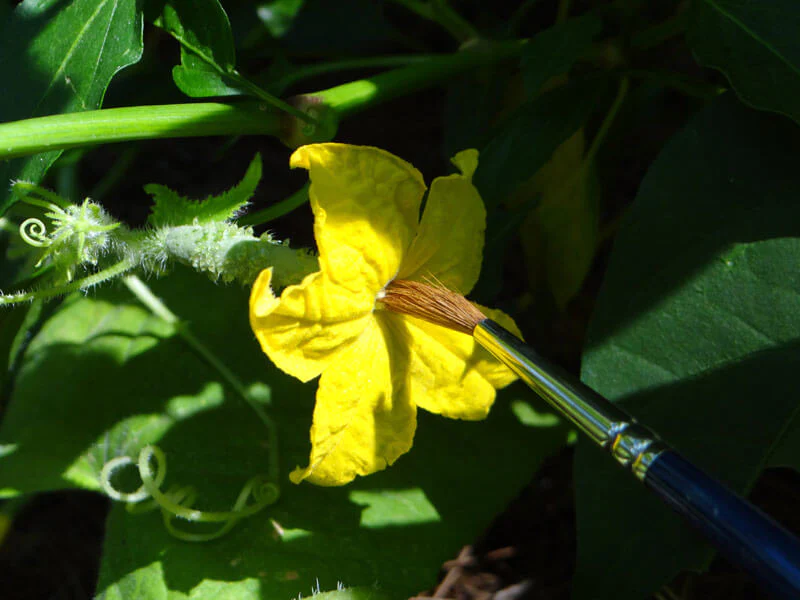For the love of cucumbers, zucchini, squash and melons

There is more happening out in that cucumber patch that you realize. The entire family of cucurbits could be considered very old-fashioned when it comes to getting together.
Both the girls and the boys stay at their parents’ house until the matchmaking pollinators bring them together. Horticulturally, this means that the flowers (that become our fruits and vegetables) are single sexed. There are boy flowers and girl flowers. Most other plants have male and female plant parts in the same flower.
These cucurbit vegetables and fruits include cucumbers, zucchini, summer and winter squash, gourds, melons and, of course, the pride of Illinois — pumpkins. And knowing this special trait of this plant family is important, particularly when the home gardener isn’t getting any fruit. There are several reasons why.
But first, a little G-rated anatomy lesson. On all of these plants that are dioecious, you can fairly easily tell the difference between the male and female flowers. (Insert jokes about looking in their “bloomers” here). The male flowers of the cucurbits have a regular stem, and the flower is attached. The female flowers, even before any pollination occurs, are borne with small unfertilized fruit on the stem that attaches to the flower. But again, why is this so important to know?
One of the common recommendations on vegetables, fruits and flowers for the home gardener is to pull off the first few flowers that form, so the plant doesn’t spend its early energy budget on making fruit. In other words, send the message that we want the plant to spend more time developing a strong root system for the long haul.
But, because dioecious plants produce separate male and female flowers, and usually produce the male flowers first, if we were to pinch off the first flowers of cucumbers, zucchini, and the rest of this specific plant family, you would be removing the male flowers; leaving, let’s say, a dormitory of girls.
Unwed girls, that can’t produce any fruit on their own. The common report from homeowners when this happens is they have wonderful plants with lots of blossoms, but little to no fruit formation. So, the blossoms just wither and die. The lesson here is, do not pull off any of the blossoms of this plant family.
But what happens when you do have plenty of male and female flowers, but still no fruit production? The cause is often the lack of a matchmaker. The pollinator. If there are not enough/or heaven forbid, no insect activity, the pollen from the male plants does not get transferred to the female plants. Once again, the blossoms wither and die with little to no fruit production.
There is also a middle ground issue here, too. Do you ever get cucumbers or zucchini that are fine on one end but then seem shriveled, not filled out or even twisted at the other end? This happens when there is insufficient pollination. So, what is this about? Are bees refusing to go to work? Well, sort of.
Remember, bees and other insects are cold blooded animals, so they can only go as fast as the temperature allows them; they can’t regulate their body temperature like mammals and other warm-blooded animals. So, on cold and rainy days, bees and other insects aren’t going to work harvesting nectar and pollen.
Another reason pollinators might be in short supply (I am sure you have heard that we are really in an insect crisis worldwide) is due to us. Specifically, all we do to our environment that depresses the numbers of insects, including pollution and overuse of pesticides. Note I didn’t say use of pesticides, but the overuse.
The unfortunate situation is that we are in a culture where many people think the only good insect is a dead one. Too bad every third food we eat is only because of pollination. But many people don’t connect that. I know right away many people want to point the finger at agriculture. But hold everything.
Farmers want the optimum situation, the best quality and quantity crop (to feed the world) with the least impact, which includes added supplies and cost. If farmers took a “let’s just treat everything for everything,” they would go broke and have less yields. So, look in the mirror if you want to see blatant overuse of chemicals, yes, the homeowner.
Think of all the homeowners’ products that say Be Gone. Bug be gone, weed be gone; then do we really have to ask why the pollinators are gone? That is why you call the Master Gardeners, to know what is appropriate to spray when and where, for the necessary and appropriate control.
OK, so, what do we do if we see no or low pollination in this group of plants? You BEE-come the bee.
Hand-pollinating is a quick way to get those cukes, zukes, gourds and melons growing in the home garden. You can use little paint brush, or I just use my finger and pick up some pollen “dust” from male flowers and then rub it into the female flowers.
You are now a pollinator, a slow and inefficient pollinator compared to insects, but you have accomplished the job at hand. And your cucurbits will be ready for harvest soon!

If bees are scarce around your flowers, you may have to take pollination in your own hands.